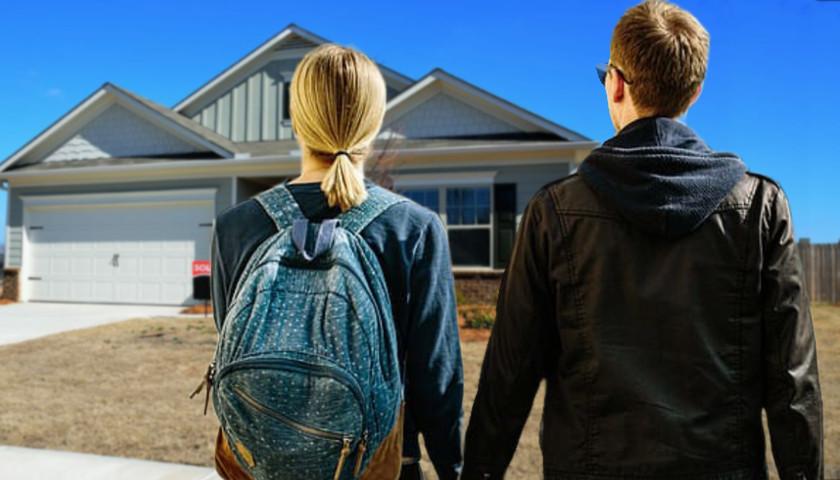by Bethany Blankley
Only 10 percent of those surveyed in a new poll said the “American dream” of homeownership is affordable, with others citing 40-year high inflationary costs, 23-year-high interest rates, limited supply of affordable housing and earnings that have eroded because of inflation.
According to a Wall Street Journal/NORC poll of 1,502 U.S. adults, the sentiment was consistent across gender and party lines, with young Americans expressing the greatest despair, saying they’ve “been priced out of homeownership.”
“While 89 percent of respondents said owning a home is either essential or important to their vision of the future, only 10 percent said homeownership is easy or somewhat easy to achieve,” the Journal reported. “Financial security and a comfortable retirement were similarly labeled as essential or important by 96 percent and 95 percent of people, respectively, but rated as easy or somewhat easy to pull off by only 9 percent and 8 percent.”
Twelve years ago, in a different survey, more than half of 2,500 polled said the American dream of homeownership “still holds true.” That is no longer the case, the Journal notes.
It also points to a study published by Massachusetts Institute of Technology, that found that 90 percent of Americans born in 1940 “were ultimately better off than their parents” but only roughly 50 percent “of those born in the 1980s were able to say the same.”
This is after a Zillow report showed that home buyers need 80 percent more income to buy a home today than they did four years ago, The Center Square reported earlier this year. Monthly mortgage payments, with 10 percent down, for a typical U.S. home had nearly doubled at the time since January 2020, according to the report.
While costs have increased, wages have not kept up. In 2020, a household income of $59,000 a year “could comfortably afford the monthly mortgage on a typical U.S. home, spending no more than 30 percent of its income with a 10 percent down payment,” Zillow noted. “That was below the U.S. median income of about $66,000, meaning more than half of American households had the financial means to afford homeownership.”
The situation is especially dire for first-time homebuyers in major cities where inflated home prices reflect limited supply and higher demand, realtors have explained to The Center Square. With more people attempting to leave the rental market, less homes are being offloaded and new construction can’t meet the demand.
Because many homeowners refinanced their mortgages when interest rates were much lower during the COVID-era lockdowns, they aren’t selling now with interest rates more than double what they were a few years ago after the Federal Reserve increased the base rate to its highest level in decades.
This is described as the “lock-in” effect, a Harvard report explains, “whereby current homeowners with below-market interest rates are disincentivized to move … dramatically reducing the number of homes available for sale.”
Due to high inflationary costs, high interest rates, low inventory, the lock-in effect and other factors, “homeownership is increasingly out of reach,” the report says.
Rents are also at record highs, having increased by more than 26 percent nationwide since early 2020, the Harvard report states. Rental rates have increased faster than income for decades. Half of all renter households, 22.4 million, were cost burdened in 2022, the highest number on record, it says. Cost-burdened is defined as renters or homeowners spending more than 30 percent of their income on housing and utilities, according to the report.
According to a Redfin analysis, 61 percent of renters can’t afford the median apartment rate nationwide, The Center Square reported.
Relief doesn’t appear to be coming any time soon, according to a Bank of America analysis. The U.S. housing market is “‘stuck and we are not convinced it will become unstuck’ until 2026 – or later,” CNN reported.
Home prices are anticipated to stay high and expected to increase due to a housing shortage. Mortgage rates are also not expected to decrease even after a base rate cut is expected this month by the Federal Reserve.
“This will take many years to work itself out. There isn’t a magic fix,” Bank of America’s head of US economics, Michael Gapen, told CNN. “The message for first-time homebuyers is one of patience and frustration.”
What’s been described as a “one-two punch” has made 2024 an historically unaffordable time to buy a home, especially for first-time homebuyers.
“It’s been a weird combination. Mortgage rates rose substantially but so did home prices. That typically doesn’t happen,” Gapen said.
Bank of America also projects that the lock-in effect could continue for another six to eight years.
– – –
Bethany Blankley is a contributor at The Center Square.






Hard to accept that 90% consider a home purchase out of their reach. I would ask them what they are willing to sacrifice to achieve home ownership? Cutting their $150 a month cell phone bill? Swapping ONE of their cars for a beater? work a second job? I am not ignoring the tidal wave against them right now but sometimes you cannot have everything at the same time. My wife and I did without in order to purchase our first home when interest rates were above 8% (thanks Jimmy Carter). Our meager income was stretched to the limit but it was worth it to us to sacrifice some comfort and luxury items to realize the American Dream. We did not wait on the government to help us which is really no help at all.